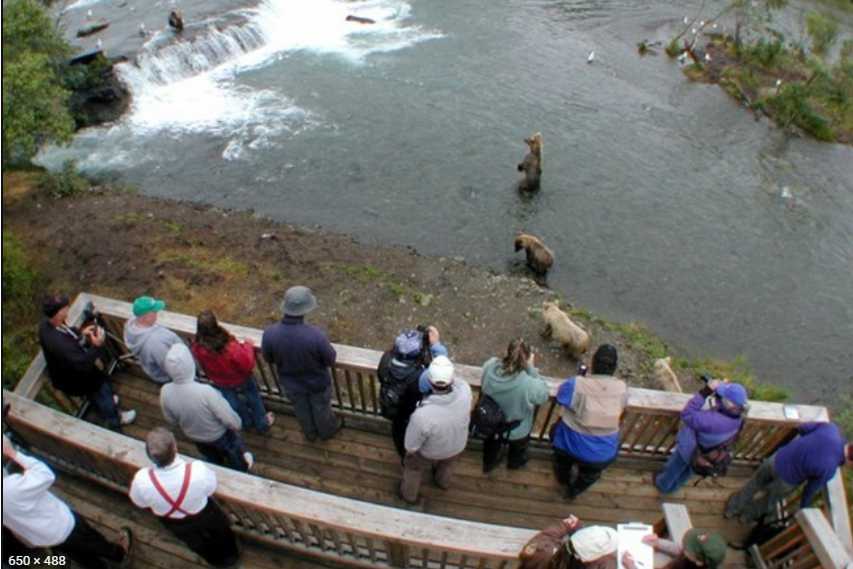
Every fall, Katmai National Park and Preserve in Alaska hosts Fat Bear Week, an annual tournament celebrating the success of the bears at the park’s Brooks River. From October 4 – 10, 2023, your vote will decide who is the fattest of the fat!
What is Fat Bear Week?
Fat Bear Week is a single elimination tournament in which Katmai National Park and Preserve invites its online community to compare photos of bears from when they first visit Brooks Falls in the spring to photos of the same bears at the end of summer. The differences are often huge. In just a few months, the bears have gorged on enough salmon to pack on some serious pounds. Fat Bear Week is fun, but it also brings up really important questions about survival and how we’re studying and learning more about these amazing bears.
How can I participate in Fat Bear Week?
Celebrate the success of Brooks River’s world-famous bears during Fat Bear Week(link is external) by placing your vote. Matchups will be open for voting between 12-9 p.m. ET (9 a.m.-6 p.m. PT) from Wednesday, October 4 to Tuesday, October 10, 2023.
By the end of the week, only one well-fed ursine will receive the title of the fattest bear. For each pairing of bears, you will be given the opportunity to vote on the bear of your choosing. Your vote decides which bear will be crowned the fattest of the year.
To make sure you’re making an informed choice, meet the bears(link is external), learn about previous champions(link is external) or watch a livestream at the bears of Brooks River(link is external). You can base your vote on many factors, such as the bear’s growth, extenuating circumstances, or which bear you think is the largest. However, Fat Bear Week is a subjective competition, so be sure to vote and campaign for your favorite!
How is bulking up beneficial to bear survival?
This week is about body positivity. A fat bear is a healthy bear! Fattening up as winter approaches is a matter of life and death for the bears: relying on stored fat for energy, they can lose up to a third of their body fat as they slow down for the winter. The more bulk they put on, the more likely they are to survive the long, cold months. And we think any fashion blog would agree that these bears look fabulous and are runway ready!
How can they eat so much? What’s on the menu?
In the fall, they enter a physiological state known as hyperphagia in which they eat non-stop and can gain up to four pounds in a single day. Some bears can eat dozens of sockeye salmon each day, with each salmon packing about 4,000 calories.
A coastal brown bear’s diet during the summer consists primarily of salmon with the addition of sedge grasses and berries. The fat of the salmon is what allows for such tremendous weight gain in a limited window. Once bears enter hyperphagia in late summer, Leptin, the chemical that tells the body it’s full, is suppressed. This allows bears to eat until it’s time to sleep. One bear was spotted eating 40 salmon in a single sitting. During this time the bears practice a technique called high grading. This is where they select the most calorie-dense parts of the fish to eat, such as the brain, skin and roe, leaving the less fatty fillets behind.
How are you measuring the bears?
Wild bears have always been challenging to measure. Terrestrial Lidar scanning technology is used almost exclusively in civil engineering fields to scan the interior of buildings, roads and gravel stockpiles to get volume measurements. As an experiment, it was used on bears at Katmai’s Brooks Camp! This was a challenge as the animals had to stay still and not move long enough to complete a scan. When the bears were standing at the top of the falls or in the river wafting to catch a fish, they were still enough that this technology worked well. This is an exciting, new, non-invasive way to collect information on the bear’s volume — especially because weighing bears is not an option.
Is there enough salmon? What’s the impact on available resources?
The last few documented salmon runs have shown high numbers — in 2019 it reached a record-breaking 62.3 million and 2021 broke that record again with almost 65 million sockeye. The 2022 salmon run was strong and healthy with aproximately 50 million sockeye. Right now, there are enough salmon to go around. The question is pointed toward the future. It’s difficult to know what kind of impacts the heat and weather patterns of this summer will have on future runs of salmon. The heat may have impacted egg survival and some streams may have dried before salmon had the opportunity to spawn. One summer may not tip the scales toward disarray, but if the heat and weather conditions continue into future years, it may be a different story. Scientists will continue to monitor and collect data regarding changes in the climate in order to help predict future trends and provide park managers with the information needed to care for this landscape.
Will female fat bears have cubs?
If a sow gains enough weight during the summer (and in this case it certainly seems she has) the chance of her having cubs is very high. After mating, the fertilized egg develops into a ball of cells known as a “blastocyst.” This blastocyst does not immediately attach itself to the uterine lining until the sow begins her torpor (semi-hibernation) state. This is known as “delayed implantation.” The sow must have enough fat reserves to continue the pregnancy, or the blastocyst may not implant itself. Cubs are usually born in the den in January or February with the actual gestation period only being about 3 months long.
What about the cubs?
At Katmai, cubs will generally stay with their mothers for two and a half years. During a cub’s first year of life, they are considered cubs-of-the-year or spring cubs. In their second year, they are generally called yearlings and will den with their mother for at least one more winter. Cubs generally stay close to their mothers, first nursing and then learning how to fish and hunt for themselves. Play among siblings is fun to watch but is also an important way for cubs to develop life skills. Male bears play no role in raising young and can actually be a threat to them.
Bears between two and a half and five years old are known as sub-adults. They are independent of their mothers, but not yet sexually mature. Some sub-adults have been part of Fat Bear Week, showing off a dramatic transition to chubby cubby.
Pages: 1 2








